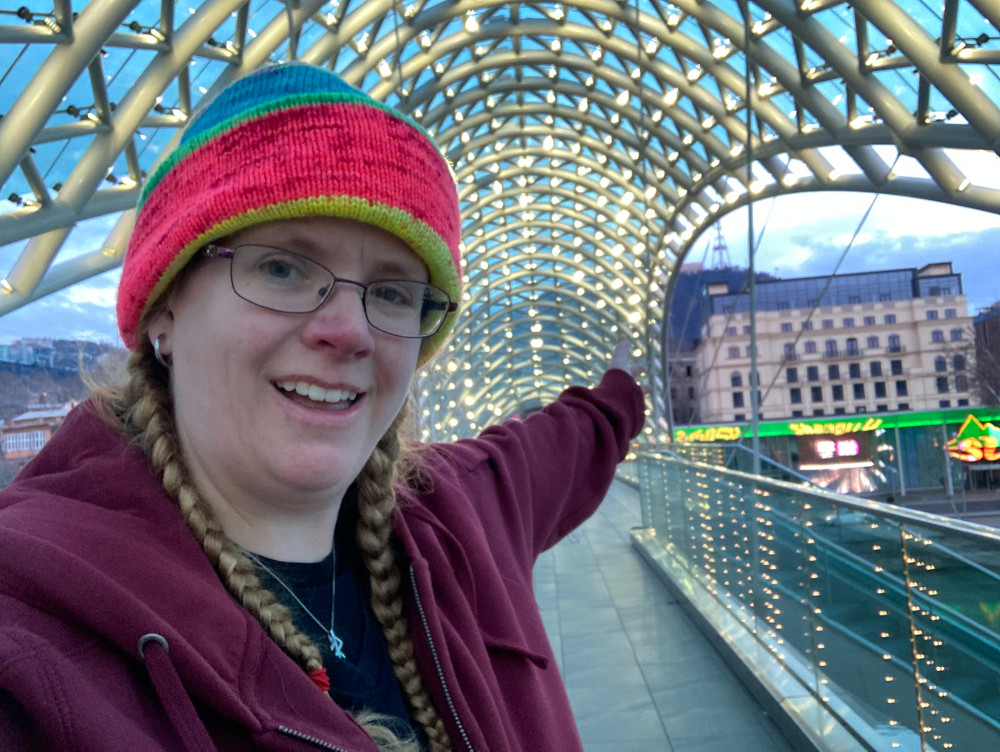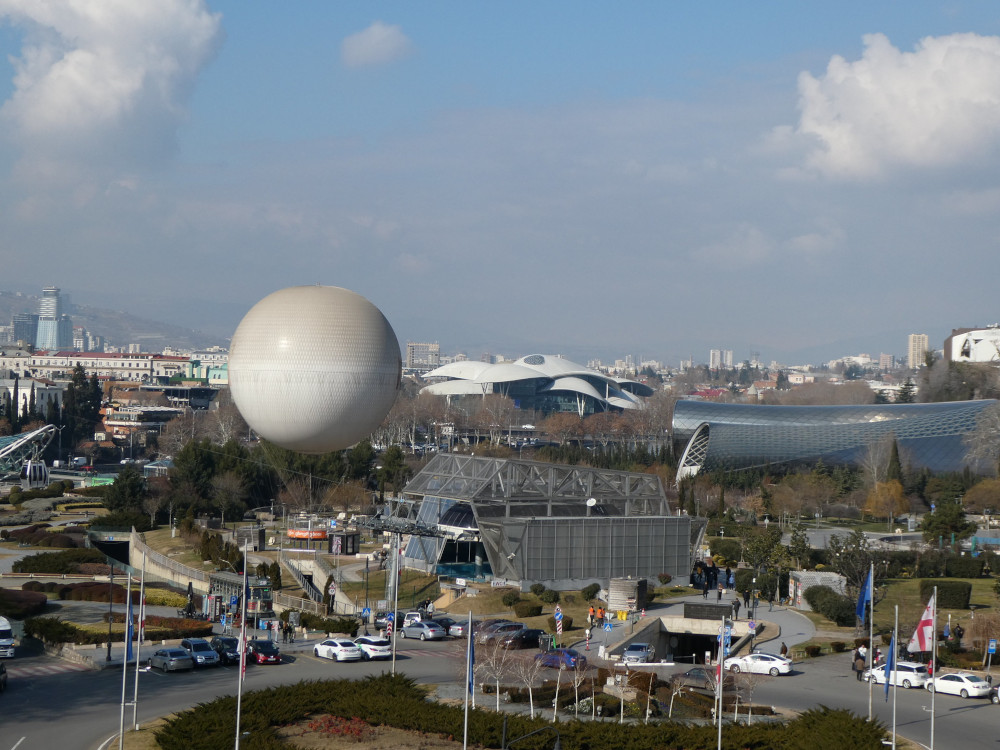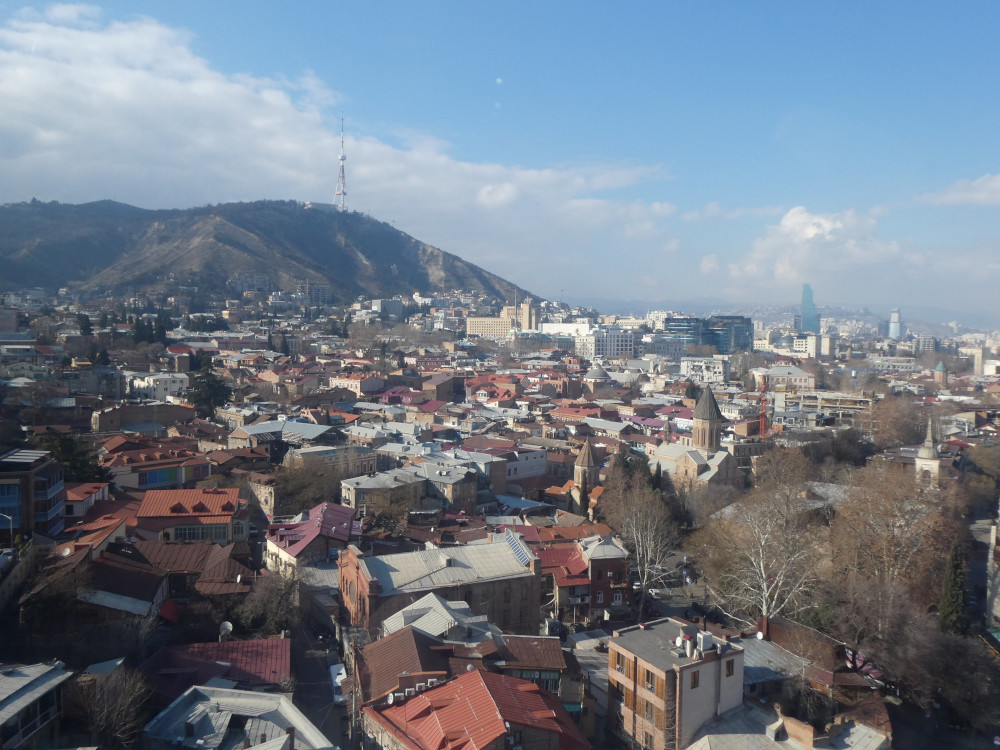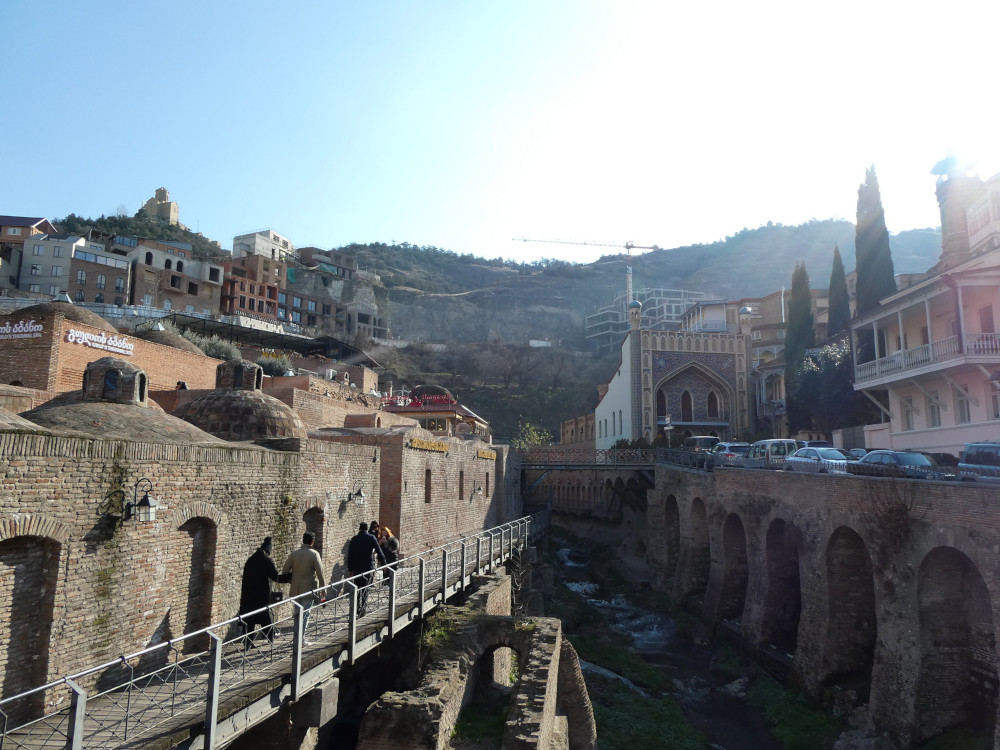I suspect I’ve said this before but I really liked the location of my hotel in Tbilisi- a five minute walk to the nearest metro station at Avlabari but also a ten minute walk to the Old Town, which meant I could go to the sulphur bath in the evening and get home quickly and easily. It also meant I could easily go out and about and explore in the few hours between Traverse trips – if I go on another, I think I’m definitely leaving more spaces in my days to spend more time exploring the destination on my own.
This would have been Tuesday afternoon, I think, after our adventure to the Chronicle of Georgia but before my sulphur bath. I had a couple of hours to explore the ten-minute distance and honestly, there’s enough to keep you going for at least a day, maybe two.

First up was Mekekhi Church, just down the road and round the corner from my hotel. This church gives its name to the street that stretches from Avlabari, the bridge below and a good chunk of the neighbourhood. Its full name is the Virgin Mary Assumption Church of Metekhi and most of it was built in the last 13th century, although rumour has it that it actually goes back to the 5th century, when Tbilisi was founded. It stands on the cliff overlooking the river and the deep hot valley opposite. We’d paused here to look at the statue of King Vakhtang on our Old Town tour – this is where blogging out of order gets complicated because I’ve already written that post but from my point of view, that was the next day and hadn’t happened yet. I glanced towards the statue and resolved to ook up who the gentleman on the horse was but most of my attention was on the church itself. It’s Eastern Orthodox and that meant head coverings. There was a basket outside with large cloths and I took one to tie around my hair for it had ties on it. Nice, very easy to put on. It wasn’t until two days later when we were in Mtskheta and required to wear skirts over our trousers that I realised I’d actually tied a skirt around my head at Metekhi.
No pictures because that’s not allowed in Eastern Orthodox churches – unless your tour guide whispers that you can do it discreetly. My interest in church interiors is pretty limited to either Norman or Gothic so I don’t see or recognise any features in this kind of church except to register that it’s kind of pretty and not unpleasing. The view from the car park is very pleasing though.

It’s also on the clifftop, looking out across Europe Square and 21st-century Tbilisi. I was surprised to see EU flags around the roundabout. Is Georgia an EU member? I didn’t know that. No, it’s not. It would like to be. It applied in March 2022, after the Russian invasion of Ukraine made it decide to hurry up the process that had been dragging on for a few years. It’s now got candidate status but it’s not granted full membership just yet because it’s still falling short in a few of the conditions it’s required to fulfil. One thing you’ll hear a lot in Georgia is whether it’s in Europe or Asia or both or neither and different people have different opinions and feelings but it does appear that the official line is that Georgia would definitely like to be included in Europe, even if it’s only for protection from its large belligerent neighbour. And so we have EU flags flying in Europe Square.

On the other side of Europe Square is Rike Park, notable for a few things. The most obvious from a distance is the hot air balloon – or rather, the helium balloon. It’s tethered and takes passengers up for fifteen or so minutes to look at the view between about 9am and 9pm, subject to weather. Its website says 9am to 3pm but I absolutely categorically saw it going all afternoon and into the evening – I have pictures of it in the air from my balcony. I wish I’d had the time to do it.

The Peace Bridge grows out of Rike Park across the river and right into the Old Town. It was built around 2010/2011 and I’m sure there was a reason for it – cities like Tbilisi don’t build ultra-modern glass-and-LED structures and name them the “Peace Bridge” for nothing but the best I can find is that it’s a physical connection between two sides of the river and symbolises “the unity and harmony sought by the people of Tbilisi”. According to Wikipedia, it looks kind of like a marine mamma but to be honest, the claim that it’s been nicknamed “the Always Ultra bridge” is perhaps more accurate. It has a glass and steel tube canopy across the top that looks a bit like a billowing sheet or pavilion frozen in time and it’s covered in 1,208 LEDs which turn it into a light show after dark. The lights ripple gently and there are motion sensors that can make the ripples emanate from pedestrians. I’m even told that there’s a Morse code message of the period table although I never noticed it. In daylight, it’s just a ripple of blue and silver in the middle of the city but definitely worth a visit and a crossing after dark.

Behind all that are a couple of interesting things I didn’t get to see except from this distance. To the right from this viewpoint is the Music Theatre & Exhibition Hall, which looks like two stylised carbon fibre tubes or horns – the kind you play rather than the kind animals grow on their head, each as tall as two or three houses. Beyond is the Public Service Hall, or House of Justice, a largely administrative building which the locals apparently call the Mushroom for its resemblance to the kind of fungus that grows in flat plates on the side of trees. If I’d had another day, maybe another two days, I could have actually visited these places. I absolutely don’t regret any of the things I chose to do but I wish I’d had the time to do a few more.
Scattered around are various other modern landmarks – the Radisson Blu Iveria, or possibly the hotel next door to it; a glass tower that sort of resembles a Dalek; the glass dome of the Presidential Palace, although the President prefers the less-official residence in the Old Town. Closer up, though, are the older buildings, embedded in the Old Town walls, with the famous Georgian wooden balconies, selling orange and pomegranate juice from their windows. I once started to say that Tbilisi is a city of two halfs – didn’t finish it because a) it’s a boring cliche and b) Tbilisi is actually a city of at least six distinct eras – there’s the 5th century remains from when it was first founded, it had a big burst of activity around the 10th century, another a couple of centuries later, there’s stuff from a couple of hundred years ago, there’s the legacy of its Soviet period and then there’s the gleaming glass of the 21st century, and all these eras are crammed in side-by-side.

Closer to my viewpoint is the Narikala cable car and this is something I did do! A few years ago, Tbilisi’s transport system moved from an orange Metro Money card to the blue Travel Card which, according to the pictures on it, covers the bus, minibuses, subway and cableway. Well, not this cableway! It covers the Turte Lake cable car and it may cover the new Mtatsminda cable car when it’s finished but this one requires the old Metro Money card. Once I’d finished looking at the view, I walked down into the square and went over to have a go on the cable car. I paid my 2 lari for the card and then 2.5 lari for a single trip. Both cards are refundable but there’s a certain amount of hassle and admin, I like to keep them as souvenirs and in case I ever go back and in this case, I wasn’t 100% sure I wasn’t going to buy the return journey when I was at the top or have another ride another day.

The cable car opened in 2012 and was a gift from Belgium. It takes about five minutes to carry you over the river and then up the mountain, to 383 metres (1,257 feet). I would have liked to get a cabin to myself – there was a family arguing over the tickets and they were still going as the cabin arrived but unfortunately, an employee ducked under the barrier, under the divider between arrivals and departures and jumped into the cabin. Do I wait for the next and share it with either the arguing family or whoever turns up behind them or do I cut my losses and just share the cabin? So I got in with her. I filmed a good portion of the ride but there was no turning the camera on myself and wittering about what I was seeing. I’ll do it here instead.

It’s a pretty spectacular view. Tbilisi is more or less wedged into a fairly narrow valley with mountains on at least two sides. Looking north as you soar over the city, you can see Mtatsminda and the TV tower – doesn’t sound like a pretty sight but it’s a very striking landmark, especially after dark, when it’s illuminated in purple. The sheer mountain side below it is also very striking. And then there’s the expanse of city below, the river weaving its way up, all the red rooftops below, Old Town giving way to medieval town to elderly town with the glass in the distance. Later in the week, I went up in the dark (got a cabin to myself, so wittering) and that’s absolutely worth making the effort for. Tbilisi glows in the dark! I can’t remember whether I’ve already said it but apparently a lot of Georgian electricity comes from renewable sources so they use it liberally in the capital to light up as many monuments and landmarks as they can. Even the cable cars light up at night, with blue, green and red LED strips on their bottoms, shifting colour as they glide over the town after dark.

But back to daylight. From the ground, Narikala looks like it’s on a mountain but once you get up there, the mountain seems to drop away very quickly. I had an idea that there was a botanical garden up there but as far as I could see, it was a dizzying abyss right behind. Good spot for a zipwire – there was a Tbilisi tour the next day that would include it and I kind of wished I’d booked onto it but I also knew that these days, I’d be petrified of stepping off the ledge and zooming down that wire and into all those trees. No, I’ll stay on the path, please.

There are two main reasons for coming up here. The first is to visit the Mother of Georgia statue. This seems to be an ex-Soviet habit, to have a huge female warrior on a high point. Georgia uses the word “mother” for anything particularly important or special to them – we recognise and understand the concept of the motherland but Georgia applies the concept to anything special. Georgia is mother, so there’s a Mother of Georgia statue. Directly underneath it is pretty much the worst angle to view it from, especially at night. I saw a lot of the Traverse lot getting great photos of it and I can’t decide whether they found a better viewpoint than I managed or whether they used drones. But that was another moment from my evening up there. In the afternoon, I looked at my watch and I looked down at the town and I decided if I wanted to find Abanotubani in time for my sulphur bath appointment, I’d have to get walking.

I had no idea how long it would take to walk down the mountain, or even whether I was going in the right direction. It looked like I was going downhill but without a map, you never quite know what’s going to happen. I knew that you could walk up the mountain and if you can walk up, you can walk down, and you can buy single journeys on the cable car but was it going ok? Yeah, it was. The path was definitely going downhill and carrying on and the city was already getting visibly closer and very soon I wasn’t so much on the side of the mountain beneath the fort but high up in the upper streets of the Old Town. There was Abanotubani directly below me, its tell-tale brick domes sticking up all over the place. I looked at my watch. Plenty of time. Time to explore Abanotubani a little before I had to go into Chreli Abano.

The final stretch down into town was steep – steep enough that I’d have struggled a lot if I was coming up, and steep enough that I had to take little mincing baby steps because any bigger and I’d have tumbled down the hill like a slinky. The path meandered down into the Old Town – from here on in, we’re in the territory of the Old Town tour from Wednesday but for me, it was Tuesday afternoon and I didn’t know anything about it. But I could find my way to the bathhouse district. I’ve done the post about that as well but for the purposes of finishing this post, Tbilisi is named after the natural hot springs in this narrow valley which was once hunting land before King Vakhtang decided to build his capital here, back in the fifth century. A hot stream still runs down the middle of Abanotubani, and there are five bathhouses built around it. A couple of hundred years ago, there were dozens here. There are also a handful elsewhere in Tbilisi but if you’re after a hot bath, Abanotubani is the place to go. And if you arrive in the evening to find you have to wait an hour before a room is available, it’s only a short walk back across the river to the cable car and a quick trip up in the dark is something not to be missed.